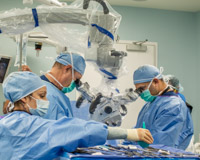Tethered spinal cord syndrome (TSCS) is a neurological disorder characterized by an abnormal attachment of the spinal cord to surrounding tissues, typically at the base of the spine. This abnormal tethering restricts the normal movement of the spinal cord within the spinal canal, leading to stretching and compression of the spinal cord and nerve roots.
Tethered spinal cord syndrome can occur congenitally, meaning it is present at birth, or it can develop later in life due to conditions such as spinal cord injury, spinal deformities, or prior spinal surgeries.
Video: DISC Patient, Neil
Neil suffered from a spinal condition that required surgical intervention by DISC specialist Dr. Luke Macyszyn.
Tethered Spinal Cord Syndrome Symptoms:
Common symptoms of tethered spinal cord syndrome may include:
- Back Pain: Patients with tethered spinal cord syndrome may experience chronic or intermittent pain in the lower back, buttocks, or legs, often exacerbated by activity or prolonged sitting or standing.
- Weakness: Patients may experience weakness or paralysis in the legs or feet, leading to difficulty walking or performing fine motor tasks, due to compression of the spinal cord or nerve roots.
- Numbness and Tingling: Spinal cord compression may also lead to sensory disturbances such as numbness, tingling, or burning sensations may occur in the legs, feet, or buttocks.
- Bowel and Bladder Dysfunction: tethered spinal cord syndrome can disrupt normal bladder and bowel function, leading to urinary or fecal incontinence or difficulty emptying the bladder or bowels.
- Orthopedic Abnormalities: In children, tethered spinal cord syndrome may cause orthopedic abnormalities such as scoliosis (abnormal curvature of the spine) or foot deformities.
- Progressive Symptoms: Symptoms of tethered spinal cord syndrome may worsen over time, particularly during periods of rapid growth or with increased physical activity, as the tethered spinal cord becomes more stretched and compressed.
Tethered Spinal Cord Syndrome Treatment:
Treatment for tethered spinal cord syndrome is primarily treated with surgery, but conservative care options may be considered to manage symptoms, particularly for patients whose symptoms are mild or who aren’t surgical candidates.
Common non-surgical treatment options include:
- Medication Management: Nonsteroidal anti-inflammatory drugs (NSAIDs) or other pain medications may be prescribed to manage symptoms of back pain or discomfort associated with tethered spinal cord syndrome. Neuropathic pain medications such as gabapentin or pregabalin may be used to alleviate nerve-related pain, numbness, or tingling.
- Physical Therapy: Physical therapy can help improve strength, flexibility, and posture, which may alleviate symptoms and improve functional outcomes in patients with tethered spinal cord syndrome. Exercises targeting core stabilization, stretching, and strengthening of the back and lower extremities may be prescribed by a physical therapist to address muscle imbalances and improve mobility.
- Assistive Devices: Assistive devices such as braces, orthotics, or walking aids may be recommended to support the spine, improve mobility, and reduce strain on the affected area. Customized orthotic devices or shoe inserts may help address foot deformities or gait abnormalities associated with tethered spinal cord syndrome.
- Pain Management Techniques: Heat therapy, ice packs, transcutaneous electrical nerve stimulation (TENS), or acupuncture may provide temporary relief from pain and muscle tension associated with tethered spinal cord syndrome. Relaxation techniques, biofeedback, or cognitive-behavioral therapy (CBT) may also help manage chronic pain and improve coping skills.
Regular follow-up appointments with your healthcare team, including neurologists, physiatrists, or pain specialists, can help monitor symptom progression and adjust treatment as needed.
It’s important to note that while conservative care options may provide symptomatic relief for some patients with tethered spinal cord syndrome, it's essential to recognize that they do not address the underlying tethering of the spinal cord.
Surgical Treatment for Tethered Spinal Cord Syndrome:
The primary treatment for tethered spinal cord syndrome is surgical detethering, especially for patients with symptomatic tethered spinal cord syndrome or progressive neurological deficit.
Surgical detethering involves releasing the abnormal attachment of the spinal cord to surrounding tissues and restoring normal mobility within the spinal canal. During surgery, the surgeon carefully dissects the tissues around the spinal cord to identify and release the tethering points. This procedure aims to prevent further neurological deterioration and alleviate symptoms associated with tethered spinal cord syndrome.
DISC surgeons perform surgical detethering using minimally-invasive techniques, which result in smaller incisions, reduced tissue damage, quicker recovery times, and the ability to return home the same day as the procedure.
In some cases, additional procedures such as laminectomy (removal of a portion of the vertebral bone) or durotomy (opening the outer covering of the spinal cord) may be performed to further decompress the spinal cord and nerve roots.
Recovery for Tethered Spinal Cord Syndrome:
When patients receive treatment for surgical detethering at an outpatient surgery center with minimally-invasive techniques, they can return home the same day. Patients may experience some discomfort or stiffness in the back or legs following surgery, which can be managed with medication and physical therapy.
After surgery, patients may be required to participate in physical therapy and rehabilitation to improve strength, flexibility, and mobility and to optimize functional outcomes.
- Rehabilitation may include exercises to strengthen the core muscles, improve balance and coordination, and promote proper posture and body mechanics.
- Occupational therapy may be recommended to address any fine motor deficits and facilitate a return to activities of daily living.
With successful surgical detethering, many patients experience significant improvement or resolution of symptoms associated with tethered spinal cord syndrome. Recovery may be gradual and some patients may continue to experience residual neurological deficits or require ongoing medical management. Regular monitoring by a healthcare provider is essential to monitor for any signs of recurrent tethering or complications and to adjust treatment as needed.
If you’re experiencing symptoms of tethered spinal cord syndrome and want to alleviate your pain, reach out to one of our spine specialists at DISC to schedule a consultation today.

About the author
discmdgroup DISC Sports & Spine Center (DISC) is a national leader in minimally invasive spine surgery, orthopedic surgery, and sports medicine care. Our spine surgeons set the standard in artificial disc replacement, spine fusion, discectomy, microdiscectomy and the full spectrum of spine procedures. The group’s orthopedic surgeons advance the state of joint preservation surgery and total joint replacement, including total knee replacement as well as total hip replacement. Our flagship surgery centers based in Newport Beach, Marina del Rey, and Carlsbad serve patients local to Los Angeles, Orange County and San Diego, as well as the rest of the country. Read more articles by discmdgroup.





